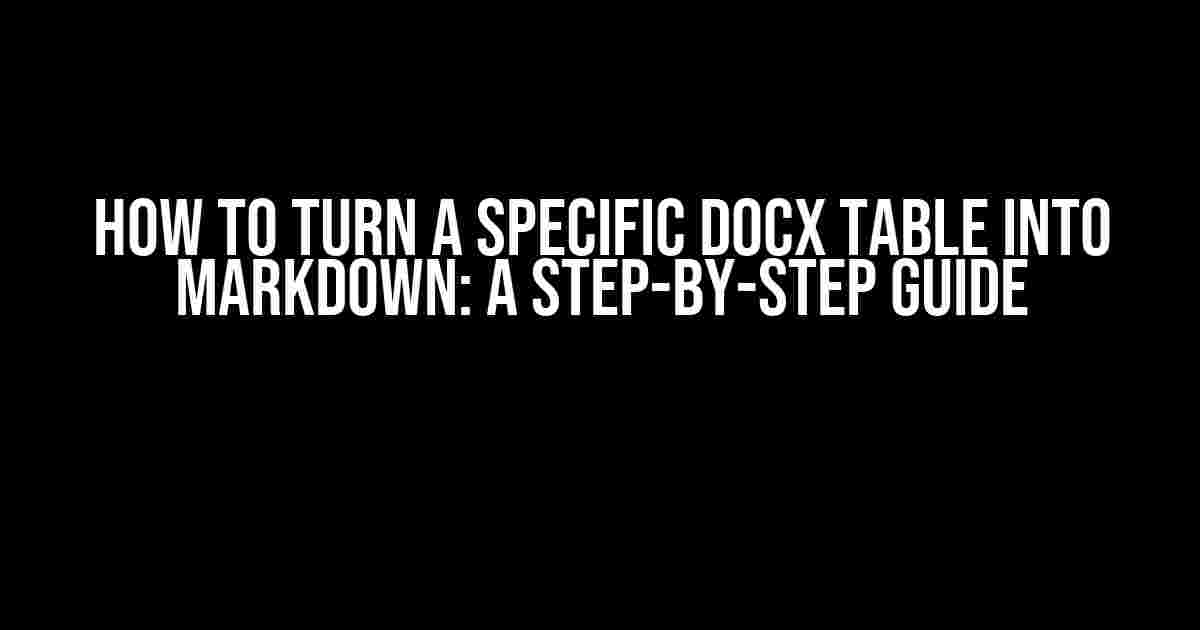Are you tired of manually reformatting tables from your docx files into markdown? Do you struggle with maintaining the same formatting and structure when converting tables from one format to another? Worry no more! In this article, we’ll show you how to turn a specific docx table into markdown with ease, using a combination of tools and clever techniques.
Why Markdown?
Markdown has become a popular format for writing and publishing content online. Its lightweight syntax and readability make it an ideal choice for bloggers, writers, and developers. However, when working with docx files, you may find that converting tables to markdown can be a daunting task. But why is markdown so important?
- Easy to read and write: Markdown’s syntax is designed to be human-readable, making it easy to write and edit content.
- Platform-independent: Markdown files can be opened and edited on any device, without relying on proprietary software.
- Flexible formatting: Markdown allows you to create tables, lists, headings, and more, using simple syntax.
Step 1: Convert Docx to HTML
The first step in turning a specific docx table into markdown is to convert the entire docx file into HTML. You can use an online tool like Online-Convert.com or a desktop application like Pandoc to achieve this.
pip install pandoc
pandoc -s input.docx -o output.htmlThis will generate an HTML file with the same content as your original docx file. Open the HTML file in a text editor to inspect the code.
Step 2: Extract the Table HTML
Identify the table you want to convert to markdown and extract its HTML code. You can do this by searching for the table’s unique ID or by using the browser’s developer tools to inspect the element.
<table>
<tr>
<td>Column 1</td>
<td>Column 2</td>
</tr>
<tr>
<td>Cell 1</td>
<td>Cell 2</td>
</tr>
</table>Copy the entire table HTML code and paste it into a new text file or a code snippet editor.
Step 3: Clean Up the HTML Code
The extracted HTML code may contain unnecessary attributes, styles, or classes. Remove any extraneous code to simplify the table structure.
<table>
<tr>
<td>Column 1</td>
<td>Column 2</td>
</tr>
<tr>
<td>Cell 1</td>
<td>Cell 2</td>
</tr>
</table>Becomes:
<table>
<tr>
<td>Column 1</td><td>Column 2</td>
</tr>
<tr>
<td>Cell 1</td><td>Cell 2</td>
</tr>
</table>Step 4: Convert HTML Table to Markdown
Now that you have the cleaned-up HTML table code, you can use a tool like Table to Markdown or a code snippet editor with a built-in converter to transform the HTML table into markdown syntax.
| Column 1 | Column 2 |
|----------|----------|
| Cell 1 | Cell 2 |Congratulations! You’ve successfully turned a specific docx table into markdown.
Tips and Variations
Here are some additional tips and variations to help you refine your markdown table conversion process:
Using Pandoc’s Markdown Output
You can also use Pandoc to convert the docx file directly to markdown, including the table. This method eliminates the need to extract and clean up the HTML code.
pandoc -s input.docx -o output.md --wrap=noneThis will generate a markdown file with the table converted to markdown syntax.
Handling Complex Tables
If your docx table contains complex structures like merged cells, nested tables, or formatting inconsistencies, you may need to use a more specialized tool like ConvertAPI or a custom script to handle the conversion.
Preserving Original Formatting
If you want to preserve the original docx table’s formatting, including font styles, colors, and borders, you can use a tool like MD2DocX to convert the markdown table back into a docx file.
pandoc -s input.md -o output.docx --wrap=noneConclusion
Converting a specific docx table to markdown doesn’t have to be a daunting task. By following these steps and using the right tools, you can easily transform your docx tables into markdown syntax. Remember to clean up the HTML code, use the right conversion tools, and preserve original formatting if needed. Happy converting!
| Tool | Description |
| Online-Convert.com | Online tool for converting docx to HTML |
| Pandoc | Desktop application for converting docx to HTML and markdown |
| Table to Markdown | Online tool for converting HTML tables to markdown |
| ConvertAPI | API for converting complex docx tables to markdown |
| MD2DocX | Tool for converting markdown tables back to docx files |
Happy converting!
Frequently Asked Question
Are you stuck trying to convert that one specific docx table into markdown? Worry no more! We’ve got you covered with these frequently asked questions and their answers.
What’s the easiest way to convert a docx table to markdown?
One of the simplest ways is to use an online conversion tool like TABLEIZER or Docx2Markdown. These tools allow you to upload your docx file, select the table you want to convert, and download the markdown version. Easy peasy!
Can I use Microsoft Word to convert my table to markdown?
Yes, you can! Microsoft Word has a built-in feature to save your file as a markdown document. Simply open your docx file, select the table, and go to File > Save As > Markdown (.md). Voilà!
What if I have a large docx file with multiple tables?
Don’t worry, we’ve got you covered! For larger files, you can use a tool like pandoc, a powerful document converter that supports multiple file formats. You can use pandoc to convert your entire docx file to markdown, including all tables, with just a few command-line arguments.
Can I customize the markdown conversion process?
Absolutely! Many of the tools mentioned above allow you to customize the conversion process to suit your needs. For example, you can choose the markdown flavor, specify table formatting options, or even write your own custom conversion scripts.
What if my table has complex formatting or formulas?
That’s a great question! In cases where your table has complex formatting or formulas, it’s best to use a tool that supports advanced features, such as automatic table detection and formula conversion. Tools like TABLEIZER or pandoc are great options for handling such complex tables.
